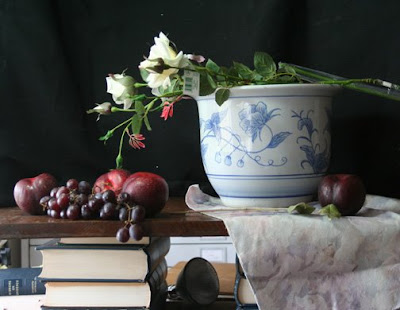
All right. When I got in the studio this morning I tested the painting to see where it was dry and where it might need more time. As I suspected, most of the painting, except for the white vase was dry. White - except for underpainting white - has a lot more oil in it and takes significantly more time to dry. No matter, I figured I could still swing a decent glaze on it. Before I began, I oiled out on most of the canvas that was dry with a bit of Maroger medium.

As you remember, I had intended to darken the background a bit and so first thing I mixed a glaze composed of thalo green, alazarin crimsen and a touch of raw umber. I laid this in with a very large soft sable brush. I mainly stayed on the edges of the painting. My intent was to bring out the light in the center of the piece and around the flowers.
I like the way this came out. Glazing into a background provides a feel of stained glass. The light hitting the canvas goes through the glaze until it hits the canvas and then bounces back. If you use pure glaze (which I haven't) from the start, the effect is quite dramatic. It bears saying here that if you intend to do your entire painting by building up all transparent glazes, then you need to make your underpainting nearly perfect and about three keys lighter than the actual values you want to achieve. The reason for this is because the multiple glazes will darken the image significantly as you proceed. I like to use a combination of opaque paint and glazes. If done correctly, this can still be quite dramatic.
My next step was to work on the fruit. Using the same combination of cad red light, alazarin crimson and cad yellow with varying degrees of naples yellow, I built up the color tops of the plums.
Then using some quinacradone magenta mixed with the alazarin crimson, I created a glaze and darkened areas of the fruit where the turning edges where and the shadows.
I used a little cad red adjusted with the magenta to make some reflected light on the plums. In cool light set-ups, the reflected light on objects is generally warm. The last step was to mix a small amount of the magenta with white and scumble this on to create the bluish haze of the plums. 
For the grapes I followed much the same steps but used a bit of cad orange to create the transparent color of light passing through the grapes.
The highlights were the same color as the bluish scumble but with a tad of naples to warm and lighten them. After applying them, I took the back of my brush and squiggled it on each highlight.
The last detail for the grapes were touches of red here and there and then, of course the stems. Just some yellow ochre. I thinned the mixture with some copal painting medium and used a small round for the detail.
At this point, I lightened the table cloth and brightened the top a bit with a scumble of naples yellow and white. If you can't get it bright enough on the first day, you usually can on the second. That cloth lit right up. I did the same for the table top, keeping my lights close to the fruit. I also used a bit of glaze in the shadows of burnt umber to darken the cast shadow directly under the fruit.
Now I turned my attention to the pot. I mixed a glaze of ultramarine blue and a bit of cobalt. I thinned this out quite a bit with Maroger and using that same small round sable brush, I laid in the design. Once I was finished with the basic design, I went back in with a liner brush and put in the outlines and details on the design. This didn't take quite as long as you might imagine. Probably the most difficult part was the single line at the top and bottom. I simplified the design overall by skipping another horizontal line that appears on the actual pot.
Lastly, I put in the reddish leaves you see on in the foliage and then using some darker blue/green glaze, I pushed some leaves back and scumbled some into the fore ground. I checked edges to be sure the ones I wanted sharp, were sharp and the rest I softened. At this point I took a cup of coffee, sat back and just visited with the patient for awhile. The last thing I did before signing the piece was to mix another darker glaze for the base of the cloth. I darkened it and then also put in the other side of the cloth behind it. If you take a look at my daily painting blog, you can get a close up of the flowers. Viola. Done.

















